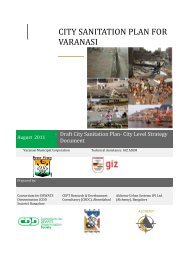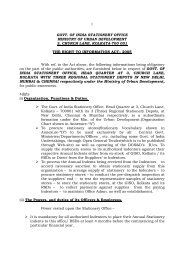CITY SANITATION PLAN - Ministry of Urban Development
CITY SANITATION PLAN - Ministry of Urban Development
CITY SANITATION PLAN - Ministry of Urban Development
You also want an ePaper? Increase the reach of your titles
YUMPU automatically turns print PDFs into web optimized ePapers that Google loves.
<strong>CITY</strong> <strong>SANITATION</strong> <strong>PLAN</strong> BAREILLY<br />
The Single VIP is a Ventilated, Improved Pit. It is an improvement over the Single Pit because<br />
continuous airflow through the ventilation pipe vents odours and acts as a trap for flies as they<br />
escape towards the light. Despite their simplicity, well-designed Single VIPs can be completely smell<br />
free, and be more pleasant to use than some other water-based technologies. Flies that hatch in the<br />
pit are attracted to the light at the top <strong>of</strong> the ventilation pipe. When they fly towards the light and<br />
try to escape they are trapped by the fly-screen and die. The ventilation also allows odours to escape<br />
and minimizes the attraction for flies.<br />
The vent pipe should have an internal diameter <strong>of</strong> at least 110mm to a maximum <strong>of</strong> 150mm and<br />
reach more than 300mm above the highest point <strong>of</strong> the toilet superstructure. The vent works better<br />
in windy areas but where there is little wind, its effectiveness can be improved by painting the pipe<br />
black; the heat difference between the pit (cool) and the vent (warm) creates an updraft that pulls<br />
the air and odours up and out <strong>of</strong> the pit. To test the efficacy <strong>of</strong> the ventilation, a small, smoky fire<br />
can be lit in the pit; the smoke should be pulled up and out <strong>of</strong> the vent pipe and not remain in the pit<br />
or the superstructure.<br />
The mesh size <strong>of</strong> the fly screen must be large enough to prevent clogging with dust and allow air to<br />
circulate freely. Aluminium screens, with a hole-size <strong>of</strong> 1.2 to 1.5mm have proven to be the most<br />
effective. The top diameter <strong>of</strong> the Single VIP should be between 1 to 1.5m and be dug at least 3m<br />
deep, although the deeper the better. Deep pits can last up to 15, 20, 30 or more years. As the<br />
effluent leaches from the Single VIP and migrates through unsaturated soils, faecal organisms are<br />
removed. The degree <strong>of</strong> faecal organism removal varies with soil type, distance travelled, moisture<br />
and other environmental factors and thus, it is difficult to estimate the necessary distance between<br />
a pit and a water source. A minimum distance <strong>of</strong> 30m between the pit and a water source is<br />
recommended to limit exposure to chemical and biological contamination.<br />
Adequacy: Treatment processes in the Single VIP are limited, and therefore, pathogen reduction and<br />
organic degradation is not significant. However, since the excreta are contained, pathogen<br />
transmission to the user is limited. This technology is a significant improvement over Single Pits or<br />
open defecation.<br />
Single VIPs are appropriate for peri-urban areas; single pits in urban or dense areas are <strong>of</strong>ten difficult<br />
to empty and/or have insufficient space for infiltration. Depending on the pit depth, depth to the<br />
ADMINISTRATIVE STAFF COLLEGE OF INDIA, HYDERABAD Page 151
















